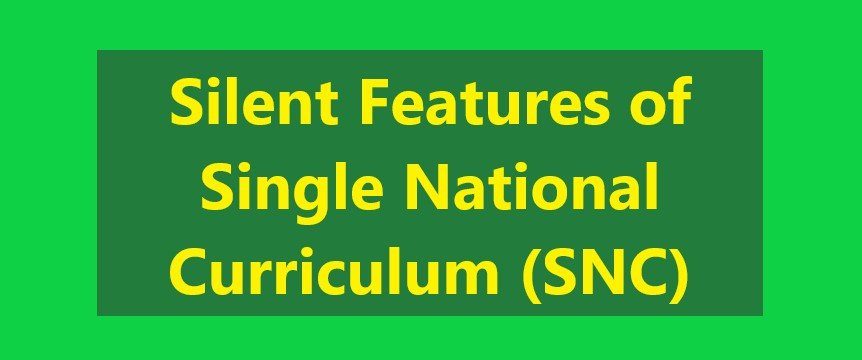Silent Features of Single National Curriculum (SNC)
Pre 1 to 5 Class in Pakistan
Key considerations and Silent Features of Single National Curriculum (SNC) All subject curricula are developed with the following key considerations in view:
• Teachings of the Holy Quran and Sunnah
• Constitutional Framework of Pakistan
• The vision of Quaid e Azam and Allama lqbal
• National Policies, Aspirations and National Standards
• Aligned with international commitments like the SDGs in particular SDG 4
- Fostering Global Citizenship, Sustainable lifestyles, culture of non — violence and peace, human rights, gender equality
• Aligned with emerging international trends in teaching, learning & assessment e.g.
- Students’ centred activity-based learning
- Assessment of higher order thinking
- Application of knowledge to real life
- Move away from rote memorization & focus on project and inquiry
- Development of 21st century skills including analytical, critical and creative thinking, communication, problem solving etc.
• Integration of Information & Communication Technology (ICT)
• Outcomes based approach with well aligned Standards, Benchmarks and Students’ Leaming Outcomes (SLOB) for each subject curriculum outlining what the students will know and be able to do for the different content areas. In 2006 curriculum all subjects did not have standards and benchmarks.
• Inclusion of comprehensive guidelines for teaching methodologies, assessment practices and textbooks & teaming materials development
• Focus on holistic development of students through integration of positive attitudes and values
- Care for self and others
- Promotion of peace, respect, tolerance, kindness, empathy towards all irrespective of gender, caste, religion and social status
- Integration of Life Skills Based and Inclusive Education
- Responsible behaviors and care for Environment and climate change
- Importance of health, hygiene and sanitation
- Respect for different cultures & religions in local and global context
- Promotion of intellectual, spiritual, aesthetic, emotional, social and physical development of learners
- Citizenship: local and global
- Practicing honesty and integrity
- Democratic values and patriotism
Alignment of Maths and Science content with framework of Trends in International Mathematics and Science study (TIMSS)
Silent Features of Single National Curriculum Early Childhood Care and Education (Pre 1)
- The ECCE curriculum has been revised keeping in view the local culture and environment alongside modern/innovative trends in ECCE and national & international commitments (SDG 4)
- Covers seven basic learning areas:
- personal and social development
- language & literacy
- basic mathematical concepts
- world around us
- physical development (newly added)
- health, hygiene & safety
- creative arts
High focus on holistic development of a child through emphasis on knowledge, skills and positive attitudes
- Increased emphasis on personality development through practice of values like patience, tolerance, empathy and citizenship.
- Incorporation of skills, respecting diversity irrespective of religion, colour, cast, creed and people with special needs.
- Competencies on child security and safety and link to technology added.
- century skills are integrated: critical thinking, creativity, problem solving, collaboration, communication skills research/probing, decision making, inquisitive learning and leadership.
- Clear guidelines for teachers, materials developers and administrators along with suggested list of ECCE materials and guidelines for creating conducive environment and assessment
General Knowledge for Grade 1 — 3 (General Science and Social Studies)
- Covers basic concepts of Science and Social Studies in an integrated manner and serves as a bridge between grade pre 1 and grade 4
- Content has been reviewed to make it relevant and age appropriate
- Fosters lifelong learning through development of inquiry and independent learning skills
- Content on child protection has been added
- Includes activities for students to improve learning and to increase students’ interest and understanding of concepts
- Increased emphasis on positive values and attitudes for holistic development of students
- More exhaustively reflects the moral values like tolerance, conflict resolution, self-
respect, truthfulness, respecting elders, appreciation of diversity, patriotism - Encourages students to develop positive attitudes at home, school, in community & country and understand their roles and responsibilities as local and global citizens
English Grade 1 — 5
- English to be taught as a language rather than subject
- Higher focus than before on the communicative competence of the language (listening and speaking)
- Addition of interactive and collaborative pedagogical strategics
- Guidelines for assessment along with scoring rubrics/marking schemes have been included
for all four language skill
English Grade 1 — 5
- English to be taught as a language rather than subject
- Higher focus than before on the communicative competence of the language (listening and speaking)
- Addition of interactive and collaborative pedagogical strategies
- Guidelines for assessment along with scoring rubrics/marking schemes have been included for all four language skills including listening and speaking which was not included in curriculum 2006
- Many new themes added to guide the content development with a high emphasis on values as well as guidelines on how to assess values and attitudes of students
- Addition of themes
- Sustainable Development Goal 4 especially Target 4.7
- Human Rights, Global Citizenship, Sustainable Development
- Gender Equality
- LSBE and Inclusivity
- Diversity of Cultures, Personal Safety, Health and Hygiene
Urdu Grade 1 — 5
- Focus on development of language skills and competencies
- Standards, benchmarks and SLOs have been added for each competency
- Competencies of ‘speech’, ‘creative writing’ and ‘aesthetic sense’ have been added
- Integration of values and attitudes like patriotism, citizenship, promotion of social cohesion
- Creation of links between language learning and other subjects
- Promotion of diversity of culture and languages especially regional languages of Pakistan
- Develops understanding and application of media literacy
Islamiat Grade 1– 5
- Islamiat is now a separate subject from grade 1 onwards. Previously Islamiat started as a separate subject from grade 3 onwards
- Curriculum was revised by both the representatives of the Federating units as well as representatives of Ittehad Tanzimat-e- Madaris Pakistan.
- There were no competencies, standards and SLOs in the previous curriculum 2006. Now, these have been added in the SNC along with their definition.
- Outcomes based and activity-based curriculum. From passive to active teaming
- According to “Compulsory Teaching of the Holy Quran Act 2017” the SLOs have been added
- In addition to Nazra Quran, a framework for reading of 200 Ahadith from I-XII has been added
- In addition to Hifz of Surahs, framework of hift 40 Ahadith from I-VIII has been added
- Addition of two strands; “Husn-e-Muamlat o Muashrat” and “Islami Taleemat our Dour-eHazir ke Taqazay”
- For primary classes, SLOs have been developed keeping in view higher order thinking
- Instructions for teachers, textbook authors and assessment experts have been added in the curriculum.
101 Books to Read Before You Grow Up
Mathematics Grade 1— 5, Silent Features of Single National Curriculum
- Gradual progression in teaching approach from grade 1 — 5 – concrete — pictorial – abstract
- Focus on developing solid conceptual foundation of Mathematics, logical reasoning skills and holistic development of learners
- Establishes alignment among Student Learning Outcomes (SLOs), benchmarks & standards, instructional design and assessment.
- Responds to SDG 4 goals such as nurturing communication, collaboration and independent
- Emphasis on linking Maths with real life situations through examples and number stories
- Several suggested activities for each content area to promote learning
- Integration of ICT through web links and students-based tasks
- Rationalization and sequencing of the content to better enable conceptual development by building from easy to complex and from concrete to abstract
- Alignment with trends in International Mathematics and Science Study (TIMSS) for the best teaching and assessment practices
Silent Features of Single National Curriculum General Science Grade 4 – 5
- Realignment of the standards, benchmarks and SLOs keeping in view latest global trends and practices in Science education
- Addition of Technology based content as separate chapters
- Integration of cross cutting themes of Values Education
- Collaborating, sharing and accepting diversity
- Bio-ethics, scientific responsibilities & care for the environment and all living beings
- Promotion of inquiry-based learning, science process skills and active teaming methodology through recommended classroom activities
- Integration of ICT into the curriculum through weblinks and project work to develop 21. century skills
- Integration of STEAM as a cross cutting strand
Silent Features of Single National Curriculum Social Studies Grade 4 — 5
- Organization of the curriculum in 6 strands including Citizenship, History, Government, Economics, Culture and Geography
- Inclusion of national, natural, global and digital citizenship education including rights and responsibilities
- New themes include local government, ancient civilizations, agriculture, entrepreneurship, anti-corruption
- Focus on democracy, patriotism and importance of rule of law
- Holistic development of students through integration of values of peaceful coexistence
- Acceptance, respect and appreciation of diversity in values, beliefs and way of life and development of essential social skills for local and global needs
- Inclusion of knowledge about ancient civilizations
Read More Books, PDFLibrary.Net











